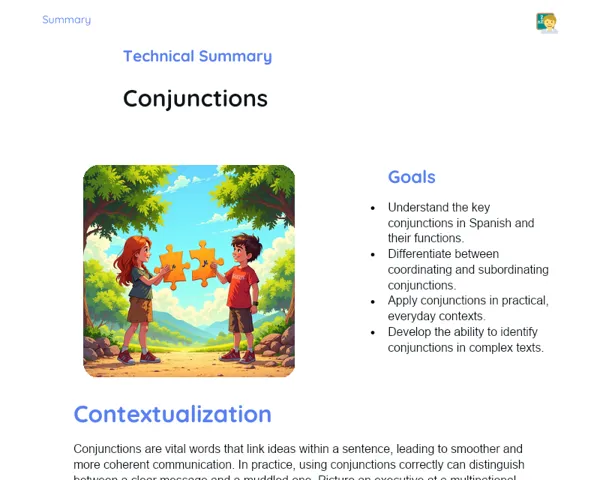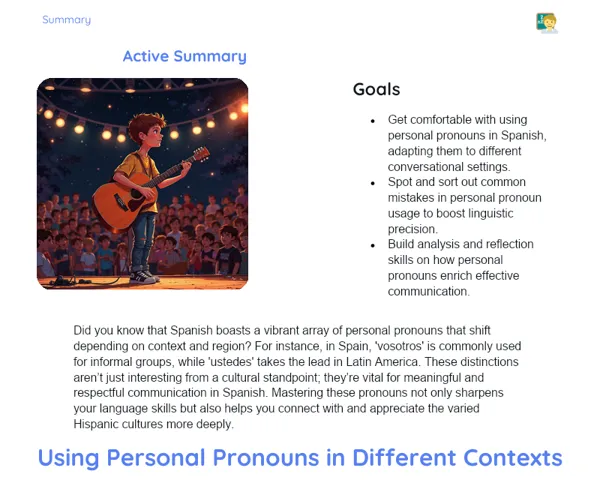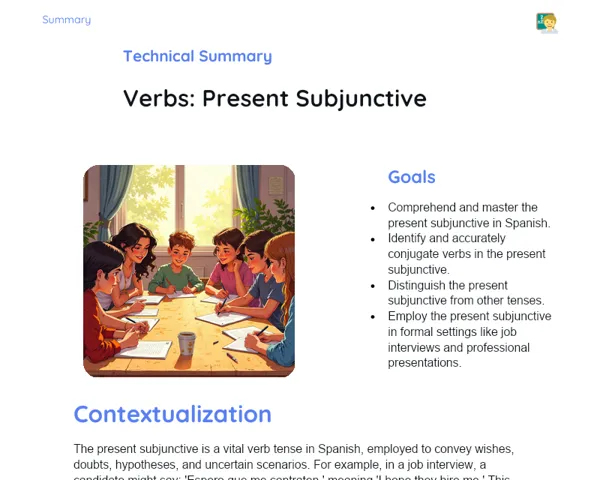Objectives
1. 🎯 Get comfortable with using personal pronouns in Spanish, adapting them to different conversational settings.
2. 🎯 Spot and sort out common mistakes in personal pronoun usage to boost linguistic precision.
3. 🎯 Build analysis and reflection skills on how personal pronouns enrich effective communication.
Contextualization
Did you know that Spanish boasts a vibrant array of personal pronouns that shift depending on context and region? For instance, in Spain, 'vosotros' is commonly used for informal groups, while 'ustedes' takes the lead in Latin America. These distinctions aren’t just interesting from a cultural standpoint; they’re vital for meaningful and respectful communication in Spanish. Mastering these pronouns not only sharpens your language skills but also helps you connect with and appreciate the varied Hispanic cultures more deeply.
Important Topics
Using Personal Pronouns in Different Contexts
Personal pronouns are crucial in Spanish for indicating who is involved in a conversation, and they change based on the context and region. For instance, opting for 'tú' over 'usted' can totally shift the tone and formality of the chat. Grasping these subtleties is key for effective conversation.
-
'Tú' and 'usted': represent different levels of formality, with 'tú' used in casual situations and 'usted' in more formal ones.
-
'Vosotros' and 'ustedes': while 'vosotros' is prevalent in Spain for informal groups, 'ustedes' is the norm in Latin America.
-
Choosing the right pronoun not only shapes how others perceive you but also influences how your message is understood.
Complement Personal Pronouns
Besides subject pronouns, complement personal pronouns are key in sentence structure as they point to direct or indirect objects. For instance, terms like 'me', 'te', 'lo', 'la' function as direct objects, while 'le' and 'les' serve as indirect objects—essential for smooth and clear communication.
-
Direct and indirect object pronouns differ according to the gender and quantity of the nouns they refer to.
-
Using these pronouns correctly is vital to avoid confusion and to communicate actions precisely and succinctly.
-
Practicing the use of these pronouns in dialogues and texts is beneficial for internalising their functions and forms.
Reinforcing and Reciprocal Personal Pronouns
Reinforcing and reciprocal pronouns serve to highlight or express reciprocity in actions. For instance, 'me', 'te', 'se' indicate that the subject and object of the action are one and the same (reciprocal), while 'mí', 'ti', 'sí' are used to strengthen the subject.
-
Reinforcing pronouns are common in Spanish for emphasising the subject, a feature less common in languages like Portuguese.
-
Reciprocal pronouns are key in situations needing clarity around reciprocal actions.
-
Practicing these pronouns in everyday life and literature aids in understanding their roles and functions.
Key Terms
-
Personal Pronouns: Words that substitute or refer to people in communication.
-
Direct Object: A noun or phrase that directly receives the action of the verb, typically without a preposition.
-
Indirect Object: A noun or phrase that receives the action of the verb through a preposition.
For Reflection
-
How might the choice of a personal pronoun alter the meaning of a sentence in Spanish? Share some examples.
-
Why is it essential to distinguish between direct and indirect object pronouns for fluency and comprehension in Spanish?
-
How can the use of reciprocal and reinforcing pronouns enhance expressiveness in Spanish discourse?
Important Conclusions
-
In this lesson, we delved into the intricacies and significance of personal pronouns in Spanish, noting how they differ depending on context and region.
-
We recognised that mastering these pronouns is crucial not only for grammatical accuracy but also for effective and culturally aware communication.
-
We examined practical examples illustrating how the choice of a pronoun can dramatically influence the tone and understanding of a conversation, underlining the importance of mastering these language structures.
To Exercise Knowledge
Write a short dialogue between two characters using personal pronouns across various contexts (formal, informal, with friends, and so on). After crafting the dialogue, review it and strive to enhance fluency and precision by swapping pronouns and observing how changes affect the conversation’s perception.
Challenge
Pronoun Detective Challenge: Locate and amend personal pronoun errors in a Spanish text. Aim to identify not only grammatical blunders but also pronoun choices that might be more appropriate in varying circumstances.
Study Tips
-
Engage with board games or grammar apps centred on personal pronouns for a fun and dynamic learning experience.
-
Watch Spanish films or series and try to spot different personal pronouns, taking note of how their use varies according to character relationships.
-
Keep a diary in Spanish and, upon reviewing, focus particularly on the use of personal pronouns, attempting to incorporate an array of forms in different entries.



